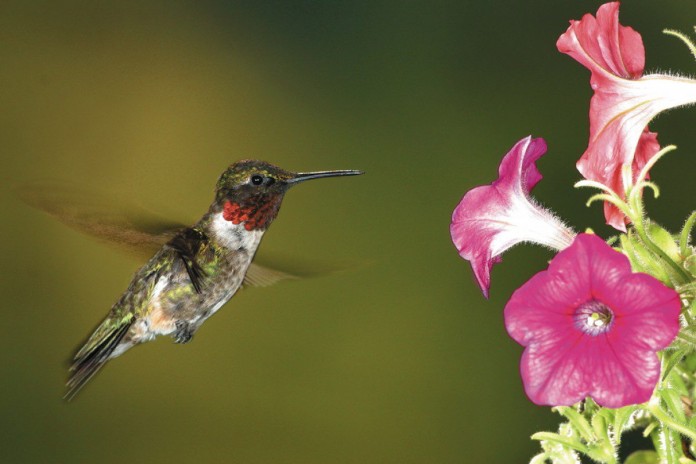If you feed hummingbirds, you should be seeing lots of activity right now. Ruby-throated hummingbird numbers peak in August.
Young of the year have left the nest (fledged) so late summer populations easily double.
Whether you see two or three hummers visiting a single feeder or can brag about “clouds” of little jewels swarming the back porch, enjoy.
These numbers will only last a few weeks.
The numbers
To estimate how many hummingbirds actually visit your backyard, use a simple formula developed by hummingbird banders.
Count the most hummingbirds you can see at any one moment and multiply by five.
If you count four hummers at your feeders simultaneously, for example, there are probably about 20 hummers visiting your backyard throughout the day.
By the end of August, adult males (the ones with red throats) will begin to head south. Adult females and juveniles will begin to follow a week or two later.
But you can expect to see hummers well into September as birds from farther north slowly move south.
Most ruby-throated hummingbirds will be gone by late September, though don’t be surprised if a few straggle through into mid-October.
An absence of late summer hummers is my cue to take down nectar feeders.
When you don’t see a hummingbird at a feeder for at least 10 days, take feeders down, clean them and store them until next spring.
Vacation woes
This predictable pattern of hummingbird behavior can lead to late summer guilt if you have a vacation scheduled for late August or September.
I faced that problem a few years ago. My wife and I took off for two weeks in late July after hosting a growing number of ruby-throated hummingbirds at our feeders.
I decided to just let the feeders run dry and force the birds to use natural nectar sources. Would the birds stay, or would they find a more hospitable backyard?
When we returned in mid-August, I immediately cleaned and refilled the feeders. By sunset, I hadn’t seen a single hummer. I feared my hummer summer might be over.
The next morning, I enjoyed a cup of coffee on the porch and waited.
Cardinals, towhees and Carolina wrens provided background music, and at exactly 7:23 a.m., an adult male zipped to one of the feeders.
Satisfied that at least one hummer returned, I went about a variety of chores the rest of the day. During that time, I saw a few more hummers, but not nearly as many as I had seen before our trip.
When I got up the following morning, about 36 hours after our return, the hummingbird activity picked up. Within just a few minutes, I could count five or six hummers at once.
By noon, hummer numbers had returned to nearly what they had been before vacation. Those results did not surprise me.
Hummingbirds are obviously very mobile and easily fly a mile to a reliable food source. In nature, they return to productive nectar patches after depleting them.
They know that flowers can replenish nectar supplies in just a day or two, so it seems they treat nectar feeders the same way.
If you’re having a good hummingbird year and plan to travel this month, chances are your hummers will return shortly after you do.
Just clean the feeders, refill with fresh nectar and give the hummers 48 hours to rediscover your nectar patch.
Tips
Meanwhile, here are some late summer hummer tips.
Mix your own nectar. Add one-part table sugar to four parts boiling water, cool and refrigerate. Red dye is unnecessary because most feeders have bright red parts.
And do not use artificial sweeteners or honey to make nectar. Both can harm hummers.
When bananas and other fruits spoil, put some on a plate near the feeders. Fruit flies and other small insects quickly detect rotten fruit, and hummers eat these soft-bodied invertebrates.
Hummingbirds rely on fruit flies, gnats, aphids and spiders to provide the protein and nutrients that nectar lacks.
Lastly, plant a few nectar-bearing wildflowers for next year. Scarlet bee balm, trumpet honeysuckle, trumpetcreeper and jewelweed can turn any backyard into a hummingbird magnet.
Related Content
- Try your hand at feeding a hummingbird
- How to plant a hummingbird garden
- How to attract hummingbirds at home
- How to garden for pollinators
- How to create a butterfly garden
- How to attract hummingbirds to your yard













